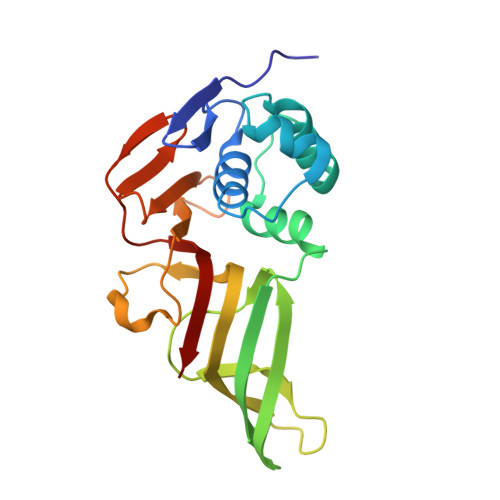Papain-Like Protease 1 from Transmissible Gastroenteritis Virus: Crystal Structure and Enzymatic Activity toward Viral and Cellular Substrates.
Wojdyla, J.A., Manolaridis, I., van Kasteren, P.B., Kikkert, M., Snijder, E.J., Gorbalenya, A.E., Tucker, P.A.(2010) J Virol 84: 10063-10073
- PubMed: 20668092
- DOI: https://doi.org/10.1128/JVI.00898-10
- Primary Citation of Related Structures:
3MP2 - PubMed Abstract:
Coronaviruses encode two classes of cysteine proteases, which have narrow substrate specificities and either a chymotrypsin- or papain-like fold. These enzymes mediate the processing of the two precursor polyproteins of the viral replicase and are also thought to modulate host cell functions to facilitate infection. The papain-like protease 1 (PL1(pro)) domain is present in nonstructural protein 3 (nsp3) of alphacoronaviruses and subgroup 2a betacoronaviruses. It participates in the proteolytic processing of the N-terminal region of the replicase polyproteins in a manner that varies among different coronaviruses and remains poorly understood. Here we report the first structural and biochemical characterization of a purified coronavirus PL1(pro) domain, that of transmissible gastroenteritis virus (TGEV). Its tertiary structure is compared with that of severe acute respiratory syndrome (SARS) coronavirus PL2(pro), a downstream paralog that is conserved in the nsp3's of all coronaviruses. We identify both conserved and unique structural features likely controlling the interaction of PL1(pro) with cofactors and substrates, including the tentative mapping of substrate pocket residues. The purified recombinant TGEV PL1(pro) was shown to cleave a peptide mimicking the cognate nsp2|nsp3 cleavage site. Like its PL2(pro) paralogs from several coronaviruses, TGEV PL1(pro) was also found to have deubiquitinating activity in an in vitro cleavage assay, implicating it in counteracting ubiquitin-regulated host cell pathways, likely including innate immune responses. In combination with the prior characterization of PL2(pro) from other alphacoronaviruses, e.g., human coronaviruses 229E and NL63, our results unequivocally establish that these viruses employ two PL(pro)s with overlapping specificities toward both viral and cellular substrates.
Organizational Affiliation:
EMBL Hamburg Outstation, c/o DESY, Notkestrasse 85, D-22603 Hamburg, Germany.















